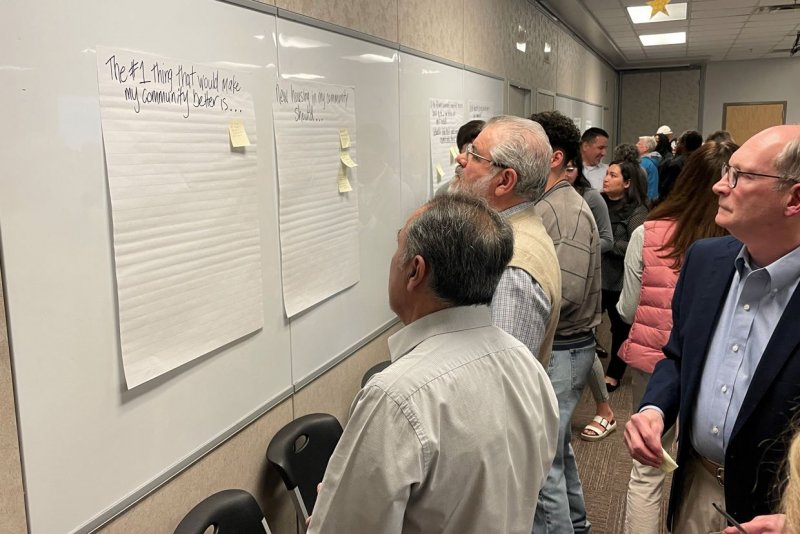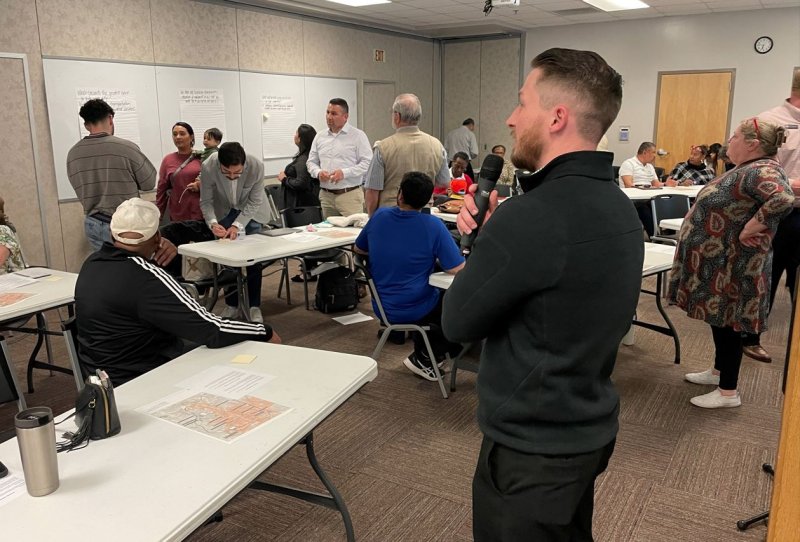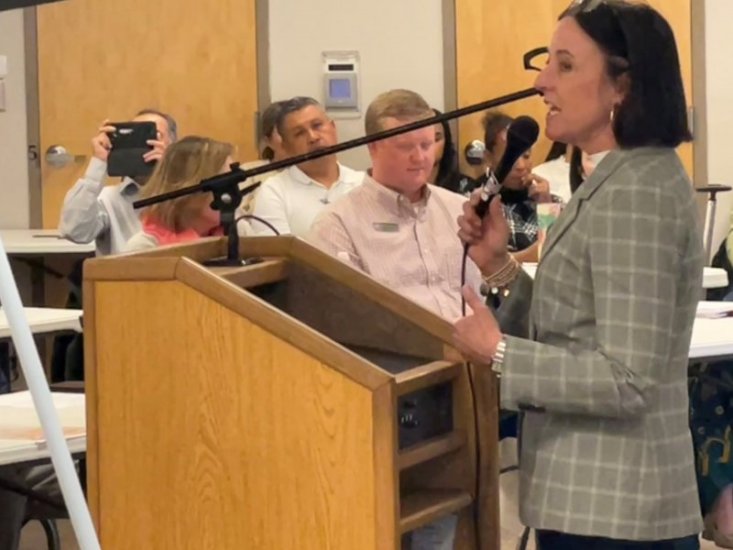Housing Listening Session Gives Planners Valuable Input
 Wednesday, February 28th, 2024
Wednesday, February 28th, 2024
Dozens of Dalton residents met with community leaders from the City of Dalton, Whitfield County, and Believe Greater Dalton (BGD) on Tuesday night for a "listening session" about housing needs in the area. The meeting included a briefing on the findings of BGD's latest housing study and also gave residents a chance to weigh in on what they'd like to see from housing developers in greater Dalton.
"This is just the beginning to a much larger conversation, but we have to start with telling our story," said Jake Bearden, Whitfield County's community development director. "We have to start with defining what we believe is missing, what we believe is needed, and since we're talking about quality of life, what are the things that we just want, what are the things we desire?"
Caption: Residents read and respond to questions about community housing needs posted by community planners
Bearden explained that the County's Metropolitan Planning Organization (MPO) is working to develop a plan focused on the community's urban center, the area bordered by the Dalton Bypass and I-75, which is the most densely populated area of Whitfield County. This transformation plan would guide development in both the City of Dalton and unincorporated areas of the County. One goal for Tuesday night's meeting was to solicit feedback from residents on the housing needs in their individual communities - whether their street, their school district, or their neighborhood. Bearden said planners wanted to develop information about what residents in Dalton's various communities can afford, and what they're hoping to see built.
"So if someone needs to fill out a re-zoning application and bring it before the Planning Commission for re-zoning, one of the things we want them to consider is that if they're building in that part of our community, please consider what you're charging or what you're asking for rent," Bearden said. "We can't make them do that and we can't infringe on property rights, but we can say that this is what the community has asked for."
 The back wall of the meeting room at the Mack Gaston Community Center was covered with posters bearing questions about community needs. Bearden asked residents to write responses for the questions on post-it notes and attach them to each poster. The questions posed by planners included, "the #1 thing that would make my community better is..." and "new housing in my community should..." among others. By the meeting's end, each poster was covered with yellow sticky notes bearing responses about parks and green spaces, access to healthcare and education services, and also restaurants, groceries, barbershops, and laundromats. Those responses will be taken back to the MPO and synthesized into a report to be used in the plan.
The back wall of the meeting room at the Mack Gaston Community Center was covered with posters bearing questions about community needs. Bearden asked residents to write responses for the questions on post-it notes and attach them to each poster. The questions posed by planners included, "the #1 thing that would make my community better is..." and "new housing in my community should..." among others. By the meeting's end, each poster was covered with yellow sticky notes bearing responses about parks and green spaces, access to healthcare and education services, and also restaurants, groceries, barbershops, and laundromats. Those responses will be taken back to the MPO and synthesized into a report to be used in the plan.
Caption: Jake Bearden speaks to residents while they write responses to questions posted in the back of the meeting room
The meeting began with Believe Greater Dalton director Allyson Coker presenting an analysis of BGD's latest housing study. Coker noted that the community had made strides tackling issues identified in BGD's previous study in 2018 with a number of new apartment complexes adding to the inventory of rental properties available in the greater Dalton area. The analysis did show, however, that 2 out of every 5 renters are cost-burdened with more than 30 percent of their monthly income devoted to rent and associated costs. Rental rates have gone up by an average of $240 in Dalton since 2020 according to the study, and that increase combined with rising costs of for-sale homes makes it difficult for many households to pay rent and move towards home ownership.
Coker said that the three main takeaways from the updated housing study had to do with the affordability of housing, the compression and concentration of Dalton's housing market, and the age of Dalton's existing housing stock. Coker reported that 80 percent of the new for-sale homes in the Dalton area delivered since 2017 were in the $200,000-$300,000 range which is considered workforce housing. Coker said that constitutes progress, but the concentration on that price point leaves supply of lower-income and higher-price tagged homes still lagging behind. Coker said the study projects a need for between 650-850 for-sale units in the next five years with significant demand at the upper-middle and upper income end of the price spectrum. The study found that 2 out of every 3 residential buildings in Dalton is at least 40 years old.
 "At that 40-year mark, that's where you begin to see some significant maintenance and upkeep issues with the home that start to occur," Coker said. She reported that the number of permits for construction had doubled in the greater Dalton area in the past five years, but that the number of new permits still lagged far behind the amount of building permits in neighboring Rome/Floyd County.
"At that 40-year mark, that's where you begin to see some significant maintenance and upkeep issues with the home that start to occur," Coker said. She reported that the number of permits for construction had doubled in the greater Dalton area in the past five years, but that the number of new permits still lagged far behind the amount of building permits in neighboring Rome/Floyd County.
Caption: Allyson Coker presents the findings of the BGD housing study
Coker said that BGD is working to meet the housing demand by developing strategies under four main themes: expanding housing choice, neighborhood revitalization, increasing affordability, and continuing downtown development. The strategies include leveraging the new Flooring Capital Development Corporation, the Dalton-Whitfield Land Bank Authority, and the Dalton Housing Authority as well as the Downtown Dalton Development Authority to search for funding opportunities, philanthropic efforts, and public-private partnerships to "move the needle" towards better housing opportunities.
Carl Campbell, the director of the Joint Development Authority, told the meeting about one such public-private partnership that will deliver 40 new workforce housing units for sale near downtown Dalton. The development, on Hamilton Street just south of Bryman's Plaza, will be built on a property that was donated to the City of Dalton by Mohawk Industries years ago that has since been sitting vacant. The JDA developed a plan for an in-fill housing development on the property and helped to obtain state grants to cover the design of new City streets, water, and sewer infrastructure for the development which will allow the developer to build and sell the homes for a lower price. The homes, which will range from 850 to 1400 square feet with one, two, and some three-bedroom plans, will be within easy walking distance to downtown Dalton.
"This is a little bit of a different plan, it is density," Campbell said. "For a long time in our community and a lot of communities, 'density' was kinda like the same word as 'poverty'. The only people that lived close to one another were poor people. And that’s not true when you go to bigger cities and bigger markets, everyone wants to be walkable to where they eat and where they shop and so we’re trying to bring a little bit of that to our community, doing it the right way."
Bearden told the gathering that there are state funding opportunities through the Department of Community Affairs that can help with other projects or developments, and that creating the transformational plan can help the community pursue those.
"There's potential to receive state funds to help with private developments and that in and of itself would help with lowering the cost of rent, lowering the cost of sale prices," Bearden said. "But we have to start somewhere and we have to have the information."
Tuesday night's meeting was the start of that process, and organizers say there will be more to come.
